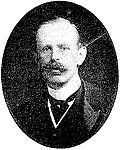(Redirected from Montgomery Boroughs (UK Parliament constituency) )
Parliamentary constituency in the United Kingdom, 1801–1918
For the county constituency called Montgomery until the 1990s, see Montgomeryshire (UK Parliament constituency) .
Montgomery was a constituency in the House of Commons of England , House of Commons of Great Britain and later in the House of Commons of the Parliament of the United Kingdom . It elected one MP , but was abolished in 1918.
After 1832 the constituency was more usually called the Montgomery Boroughs or Montgomery District of Boroughs .
Boundaries
1885–1918
The constituency comprised the boroughs of Montgomery , Llanfyllin , Llanidloes , Newtown and Welshpool .
Members of Parliament
1542–1640
1601–1918
Elections
Elections in the 1830s
The election was declared void on petition, causing a by-election.
Elections in the 1840s
With both Cholmondeley and Pugh receiving the same number of votes, both were declared elected by the returning officer. However, Cholmondeley decided against defending his claim for the seat and Pugh was declared the only elected candidate.
Elections in the 1850s
Elections in the 1860s
Pugh's death caused a by-election.
Willes-Johnson's death caused a by-election.
Elections in the 1870s
Hanbury-Tracy succeeded to the peerage, becoming Lord Sudeley.
Elections in the 1880s
Pryce-Jones Elections in the 1890s
Philipps Elections in the 1900s
Rees Elections in the 1910s
General Election 1914/15 :
Another General Election was required to take place before the end of 1915. The political parties had been making preparations for an election to take place and by July 1914, the following candidates had been selected;
References
^ "History of Parliament" . History of Parliament Trust. Retrieved 28 November 2011.
"History of Parliament" . History of Parliament Trust. Retrieved 28 November 2011.^ Stooks Smith, Henry (1845). The Parliaments of England, from 1st George I., to the Present Time. Vol II: Oxfordshire to Wales Inclusive Google Books .
Churton, Edward (1838). The Assembled Commons or Parliamentary Biographer Google Books .Hon. Hugh Cholmondeley and David Pugh tied, with 389 votes each, and the returning officer made a double return. However, when a petition was lodged against Cholmondeley he decided not to defend his claim, and Pugh took the seat.
^ Escott, Margaret. "Montgomery Boroughs" . The History of Parliament . Retrieved 5 May 2020.
^ Craig, F. W. S. , ed. (1977). British Parliamentary Election Results 1832–1885 (e-book) (1st ed.). London: Macmillan Press. ISBN 978-1-349-02349-3
"Election Intelligence" . Exeter and Plymouth Gazette . 17 July 1852. p. 7. Retrieved 22 August 2018 – via British Newspaper Archive ."Montgomeryshire Boroughs" . Evening Mail . 12 July 1852. p. 5. Retrieved 22 August 2018 – via British Newspaper Archive ."Political Intelligence" . Brighton Gazette . 6 August 1863. p. 7. Retrieved 5 March 2018 – via British Newspaper Archive ."File NLW ex 1977 – Thomas L. Hampton Canvass Book" . National Library of Wales ^
^ Craig, FWS, ed. (1974). British Parliamentary Election Results: 1885–1918 . London: Macmillan Press. ISBN 9781349022984
^
^
D Brunton & D H Pennington, Members of the Long Parliament (London: George Allen & Unwin, 1954)
Cobbett's Parliamentary history of England, from the Norman Conquest in 1066 to the year 1803 (London: Thomas Hansard, 1808) The Constitutional Year Book for 1913 (London: National Union of Conservative and Unionist Associations, 1913)F W S Craig, British Parliamentary Election Results 1832–1885 (2nd edition, Aldershot: Parliamentary Research Services, 1989)
Leigh Rayment's Historical List of MPs – Constituencies beginning with "M" (part 3) Categories :
Text is available under the Creative Commons Attribution-ShareAlike License. Additional terms may apply.
**DISCLAIMER** We are not affiliated with Wikipedia, and Cloudflare.
The information presented on this site is for general informational purposes only and does not constitute medical advice.
You should always have a personal consultation with a healthcare professional before making changes to your diet, medication, or exercise routine.
AI helps with the correspondence in our chat.
We participate in an affiliate program. If you buy something through a link, we may earn a commission 💕
↑


